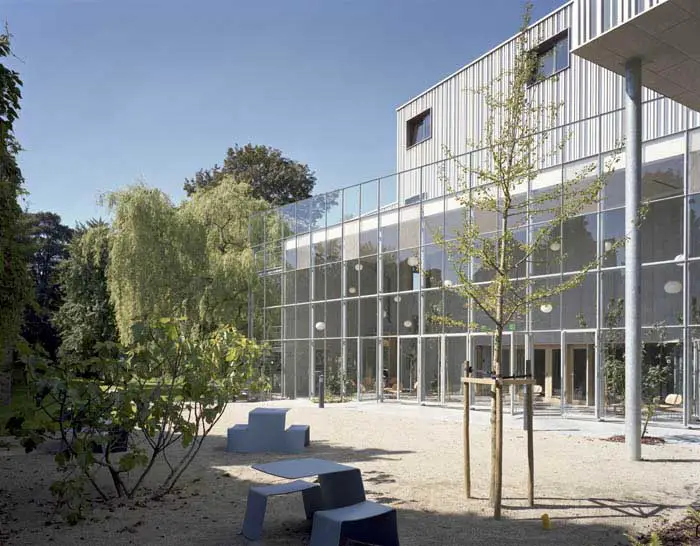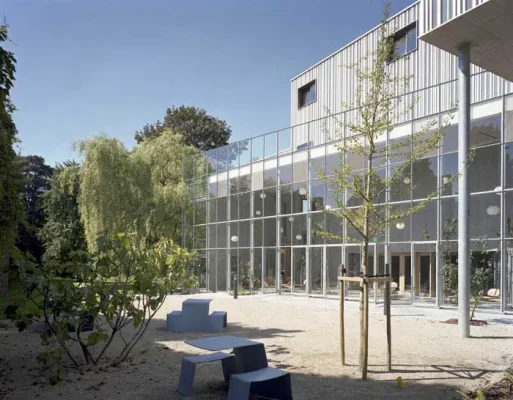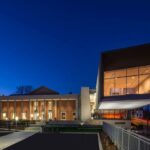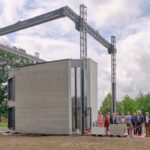Charleroi Photography Museum Belgium, Wallonia-Brussels, Architecture Image
Charleroi Museum of Photography Architecture
Belgian Building – design by l’Escaut Architecture
Charleroi Museum of Photography Extension
Location: Mont-sur-Marchienne, Belgium
Date built: 2008
Design: l’Escaut Architecture
Charleroi Museum of Photography
Approximate building construction cost: €3.6m
Word of introduction
Press release
Practical information
The 3 exhibition focuses
Focus on the new hanging : photography in the 19th century
Focus on the new hanging : photography in the 20th century
Architectural point of view
l’Escaut Architecture
Jeanine Cohen
Jean-Paul Hubin, instant portraits
Vidéographie
Charleroi Photography Museum
INTRODUCTION
Charleroi Museum of Photography, cornerstone of the architectural policy of the Ministry of the Frenck-speaking Community Wallonia-Brussels.
Architecture, as a reflection of lifestyle and identity, is characterised by its constant presence in the everyday life of each citizen. It is enshrined in history and constitutes our common cultural heritage. In this respect, it affects us all and forms a mode of artistic expression that should be recognised as such. But if architecture is undoubtedly the result of an act of creation driven by a designer, it is primarily generated on demand. The owner is thus seen as a founder, in consultation with users present and future. He must define, in addition to any requirements or programmes, the meaning and values he intends to convey through the emergence of a building. Architecture can no longer be considered a mere commodity but must be recognised as an artistic and intellectual contribution to a project. A project which demonstrates a strong sense of purpose to live, work, entertain, educate, discover, assemble, administrate etc., while interacting with its natural, built and social environment and exhibiting a determined modernity. The Charleroi Museum of Photography is implementing a perfect example of such a citizen-driven project, working with the Museum Directors, the local population and the Commune of Charleroi to reflect on development of the area around the site.
Owners and public sponsors in particular are urged to recognise the cultural and personal values inherent to the act of building. Our actions and cultural policies must reflect education and respect for a quality-built environment. Philosopher to our architectural policy is the MAC (Musée des Arts Contemporains du Grand-Hornu – Grand-Hornu Museum of Contemporary Arts) while our guide is undoubtedly the Service des Infrastructures Culturelles [Cultural Infrastructure Service], which manages 55 sites in Belgium and abroad (cinemas, cultural centres, libraries…and the Charleroi Museum of Photography). Through the publication of a collection of books entitled Visions. Architectures Publiques [Visions. Public architecture], one of which will feature the Museum and all of which will be translated into English, through the European Forum for Architectural Policies, where it plays an active role, and through the establishment of the Cellule Architecture [Architecture Group] (2007), the Minsitry of the French-speaking Community Wallonia-Brussels intends to develop an architectural policy of the highest possible quality.
Jacques Lange,
Architect, Directeur des Infrastructures culturelles [Director of Cultural Infrastructure],
Chantal Dassonville,
Architect, Directrice générale adjointe f.f. [Assistant Director General]
Direction générale de l’Infrastructure [Directorate General for Infrastructure]
Minsitry of the French-speaking Community Wallonia-Brussels
In addition to the Charleroi Museum of Photography, the Minsitry of the French-speaking Community is also opening another building emblematic of its architectural policy –the Cinéma Sauvenière in Liège (Vers plus de bien-être architects, www.vplus.org).
Charleroi Museum of Photography Building Extension
2008 – the Belgian Museum of Photography is expanding
After its renovation in 1995, the Museum of Photography in Charleroi (Belgium) is preparing to experience a new evolution through the opening on 1 June 2008 of a new wing adjoining the Carmelite convent, cofinanced by the French-speaking Community Wallonia-Brussels and the European Union ERDF funds. The museum will become the largest and one of the most important museums of photography in Europe (8000 m2), with a collection of 80,000 photographs, more than 800 of them on permanent exhibition, and the conservation of three million negatives. Designed by l’Escaut Architecture, this contemporary wing greatly extends the exhibition area (from 1550 m² to 2200 m²) and allows visitors to have access to a new library, a projection room, a boutique and a “Museum Café” opening onto an enormous park.
In spite of the significant development that it benefited from ten years ago to adapt better to its new function, the former Carmelite convent of Mont-sur-Marchienne offered too little space to allow the Museum of Photography to increase its influence and to respond to new needs concerning exhibitions, programming, management and educational tools. Financed by European funds and by the French-speaking Community of Wallonia-Brussels, the new contemporary wing of the museum will see the light of day on 1 June.
These new exhibition halls will offer a new scale to the presentation of the permanent collections, making it possible to go more deeply into the history of photography and doubling the area of picture rails devoted to the leading pieces of the collection. The educational service will benefit from an enormous room facing the park, equipped for digital studios and in direct connection with the Discovery Path developed in the south wing of the former Carmelite convent. In the park, a new library (its former location will become a shop), an auditorium that will enable the presentation of multimedia works and “The Museum Café” will welcome the public independently of access to the exhibition. In the underground levels and on the second floor the technical rooms, photography laboratory, joinery and cutting workshops, storage areas for works and materials will all be located. The temporary exhibitions will be presented in the halls of the former Carmelite convent at the rate of three simultaneous exhibitions every four months.
The new building is the result of a long process of maturation that started at the beginning of the 1990s with Georges and Jeanne Vercheval and was supported jointly by Olivier Bastin and Eloisa Astudillo (l’Escaut Architecture), Xavier Canonne, director of the museum, and the Department of cultural infrastructure of the French-speaking Community.
Established in the park of the former Carmelite convent, the new wing will redistribute the functions both in the interior (programming) and in the exterior of the museum (the park will become public and will connect the adjoining public facilities) within a vision that encompasses the neighbourhood and spreads to the adjoining public areas. Designed in successive hollows, the new building combines the framing and view of the park and surrounding areas which consequently will become focal points or backgrounds for the spatial staging. The museography will take over this external experimentation and reproduce it in the form of multiple views.
The specific nature of this audacious construction is expressed primarily by two elements: its wooden structure (the techniques used are a first in Europe) and its envelope of aluminium, created by the Belgian artist Jeanine Cohen. This envelope will offer both a depth and a vibration, changing according to the light and the time of day. The building is in a permanent “photo composition”.
Thanks to these new tools for preservation, accommodation and development, the Museum of Photography of Charleroi (centre of contemporary art of the French-speaking Community Wallonia-Brussels) is consolidating its anchoring and its influence both on the local and on the national and above all international level, because it will become the most enormous and one of the most important museums exclusively devoted to photography in Europe.
Management
Xavier Canonne
Architects
L’Escaut Architecture
Contracting authority
Ministry of the French-speaking Community Wallonia-Brussels,
Service of Cultural Infrastructures
PRACTICAL INFORMATION
Date of opening of the new wing
1 Jun 2008
Hours: Tuesday through Sunday, 10.00 to 18.00
Entry price: starting with the opening of the new wing: individuals: 6€ – seniors, teachers (with school identity card), groups starting at 10 people: 4€ – students, unemployed: 3€ – Article 27: 1.25€ – under age 12: free of charge
Groups and guided tours
Amélie Van Liefferinge, educational department, 071/43.58.10, [email protected]
Possibility of guided tours after hours
Price: entrance 4€ (student 3€ – free of charge for under age 12) + cost of the guided tour (1.5 hours – 20 people per group): 50€ during the week (40€ for school groups), 60€ on the weekend, 70€ after hours and holidays
For company events
Cécile Druart – [email protected]) 071/43.58.10
Hours: slots in timetable depending on the halls reserved
Price: depends on the halls reserved (dossier on request)
THE THREE EXHIBITION FOCUSES
A new hanging of the permanent collections
Besides the new spaces of the Museum Café, the library and the auditorium, the new wing of the Museum of Photography will allow a wider presentation of its permanent collection. With nearly 80,000 photographs and three million negatives, for too long a time the collection has been short of space, forcing it to an arrangement that is too reductionist. Numerous major works could not be exhibited there, leading to various gaps in its historical sequence. The collections of the 19th and 20th centuries have been entirely re-thought.
New halls have been rearranged, offering a chronological and thematic hanging that is better structured on the ground floor and the first floor of the Carmelite convent. Photography in Belgium is now integrated better into a wider international context; illustrated period documents and works that helped in the dissemination of the photographic medium will be exhibited there, as well as excerpts from avant-garde films and experimental videos from the end of the 1960s. Naturally the new wing will see the hanging of representative works of the last twenty years. However, the amplitude of the spaces and their arrangement, intended for the collection, will promote a presentation constructed around themes and confrontations throughout the different eras of photography in a stimulating reading of them.
The temporary exhibitions
Nine exhibitions per year, at the rate of three simultaneous exhibitions, will go more deeply along the innumerable paths that the photographic image has taken. Every four months creative, documentary and historical aspects will follow each other to sketch out as wide a panorama as possible of photography, both Belgian and international, historical and contemporary.
From 10 May to 14 September 2008
“Hugues de Wurstemberger – Retrospective”
“Dave Anderson – Rough Beauty”
“Nikon Press Photo Awards 2007”
From 20 September 2008 to 18 January 2009
“Palestine inventée” (Invented Palestine)
“The First World War in the museum’s collection“
“Erika Harrsch – Eros-Thanatos”
From 24 January to May 2009
“Fred Baldwin & Wendy Watriss”
“Christian Lutz – Protokoll”
The Discovery Path…
This playful path in the pedagogical section of the museum is intended for all people who are curious to learn and to allow themselves to be surprised. Photography, its nature, its language, its specific features are presented in an instructive and amusing way, whether in a studio from the 1900s, through optical illusions or manipulations of images. Finding out about photography in this space can be effectively completed by a workshop in the traditional laboratory working with silver salts or the brand-new digital laboratory.
Besides these three exhibitions focus, the museum is equipped with a new projection room with retractable rows of seats that will offer a schedule of art films and video works.
FOCUS ON THE NEW HANGING OF THE 19TH AND 20TH CENTURY COLLECTIONS
Photography in the 19th century
The invention of photography at the beginning of the 19th century contributed to the technological upheavals that would go on to shake society to its core. Research into how to fix and preserve an image of visible reality by projecting it in a dark room was developed principally in France and England.
The oldest known photograph is attributed to the Frenchman Joseph Nicéphore Niépce (1765-1833). The “view from a window of Château du Gras” taken around 1826 required almost an entire day to take. The invention of photography was officially unveiled in Paris on 19th August 1839 in the form of daguerreotypes.
Within just a few months, photography went from being a scientific curiosity to a marketable product; recognition was universal.
The daguerreotype, invented by the Frenchman Daguerre (1787-1851), one-time partner of Niépce, was a direct and unique positive image. In the early 1850s, this technique was gradually replaced by the negative/positive process patented by the Englishman William Henry Fox Talbot (1800-1877).
Photography was rapidly applied to all possible sectors: portraits, heritage, science, war, landscape, reproduction of works of art and as models for artists. Everything was ripe for photographing in this society that yearned to conquer the world by means of images so that it could take possession of it, understand it and thereby master it.
During the 19th century, improvements aimed above all at achieving optimal reproducibility for the lowest possible cost, reducing posing times, increasing flexibility of use and improving stability.
Amateur photography developed more widely with the introduction of the Kodak in 1889, the first camera that did not require any technical skills. At the same time, photography’s widespread fame brought with it the question of its artistic merits.
Pictorialism, which aimed to elevate photography to the status of the other arts, was the first international photography movement and enjoyed great success with exhibitions, international fairs and even the publication of luxurious reviews. However, the First World War marked the end of the movement and also a break with the 19th century.
Photography in the 20th century
A century of torment, confusion, war, technological progress, accelerated communication, revolutionary discoveries, hopes, utopias and globalisation, the 20th century represented the dawn of a new era for photography. Its appearance in the press, as well as its widespread mediatisation, opened up new possibilities and commercial applications.
Taking advantage of technical progress that saw cameras becoming ever smaller and easier to handle, photo-journalism bore witness to the state of the world and brought to life events that were widely reported by illustrated magazines. Some photographers were engaged in highlighting human tragedy and injustice, whilst others adopted a more humanistic line and revealed the human condition in all its dignity.
Photography started to appear within family settings in the 1930s. In parallel, its artistic status was recognised by means of its own language, discovering the real by means of a new and unexpected angle. It was integrated into avant-garde, futurist, Dadaist, constructivist and surrealist movements, enlarging its potential and enriching our vision and perception of the world. Photographers’ personal projects proliferated and were presented in galleries and on the art market, in sections of museums (the Museum of Modern Art, New York, 1940) and in specific institutions in the United States, and then in Europe from the late 1960s.
Historical, aesthetic and theoretical works multiplied, and photographers’ works were the subject of monographs and detailed studies.
Photography now forms an integral part of the visual arts, forming a stimulating dialogue with other forms of expression.
More than ever before, photographers nourish our visual imagination, presenting what we only vaguely feel and “increasing our feeling of existence” (Kenneth White).
But is photography a window or a mirror? A view of reality or a reflection of the photographer’s subjectivity? The two complement each other: a window can open onto a mirror and a mirror can reflect a window. There are billions of images and a museum of photography is like an aquarium in an ocean…
THE MUSEUM OF PHOTOGRAPHY IN CHARLEROI – ARCHITECTURAL POINT OF VIEW
Hidden within an urban island, the new wing of the Museum of Photography in Charleroi is rooted in the orchard of an old Carmelite convent. A park, rich in remarkable trees taken up in the inventory of the heritage, completes this landscape, isolated from outside gazes and marked off by an enclosing wall. Today a sport complex and a commune school back up to the wall of the enclosure, while private gardens come up against the impressive masonry.
By taking its position in the park, the new wing of the museum invites the visitors to commit to this place, just like the inhabitants. The park creates the link between three social functions: teaching, culture and sport. Its opening to the public has become an issue in social dynamics and urban change.
The city of Charleroi shared in this vision by submitting an ‘urban renovation master plan’ for the area concerned as a candidate project for the Feder Fund 2007. The development of the Place Communale and that of the Essarts, neighbouring the museum, are positioned as intermediaries of the Feder Fund 2000-2006 on which the budget for the new wing was partially based. Located on the edge of the city centre, through the international aura of the Museum, this urban pole will constitute a positive sign for the future of the city, echoing the airport, located on the other slope of the valley of the Sambre.
As if to put a question to the neighbourhood, the new wing is designed in successive hollows generating lines of flow toward the neighbouring structures. These structures thus become focal points or backgrounds for a spatial theatre design. The multiple shapes constitute the foreground, taking on meaning through the relationships they maintain with the context (park, homes, equipment, etc.) The interior routes take hold of this exterior experiment and reconstitute it in the form of multiple gazes.
The architecture plays with incessant interior/exterior relationships and subverts their boundaries: while crossing the windowed hall of the old Carmelite convent, the stroll is suddenly projected into the park; the overhang hollows out into a light well to illuminate an undergrowth hung with ferns; the winter garden shelters fruit tree species that diffuse their perfumes inside the museum. Each space thus constitutes a place on its own, while serving as an ‘antechamber’ for the places that follow it. Interspaces, or inter-places in a manner of speaking.
Following the formula 1+1 = 1, the new wing fits in with the continuity of the Carmelite convent to form a single institution. The programming of the ‘extended’ museum follows from six months of maturation with Xavier Canonne, Museum Director. During this period, the functions will be divided between the two buildings in a “domino effect”: while moving certain existing functions, others have taken their place, and so on.
Although the new wing was inaugurated this year, building it was already planned at the time of the first renovation of the former Carmelite convent. The Museum of Photography in Charleroi, arising from the commitment of Georges and Jeanne Vercheval, has occupied the Carmelite convent since 1987. In 1993, l’Escaut stepped in to assist in the incorporation of works by the artists Francis Alÿs, Edith Dekyndt, Jean-Claude Saudoyer and Marc Feulien within the framework of works already launched. Afterwards, l’Escaut became the pilot for the entire renovation project, which was completed in 1995.
The transformation of the former Carmelite convent into a photography museum caused a dramatic change in the logic present in the building: from prohibiting people from looking for religious reasons, we went to the revelation of the image for societal reasons. Its extension challenges the conventional logic of museums by multiplying the relationships between photography, its history and the numerous facets of its representation.
Concerning its construction plan, it constitutes a first in Europe: the use of solid thick plywood as structural supports for the overhang is the result of the experience of the stability firm Weinand concerning distinctive structures of wood. Yves Weinand is a professor at the EPFL of Lausanne and is supplying this project with his know-how at the international level.
Through the work of Jeanine Cohen, all this richness takes flight, establishing a connection with the sky and with the light. Put at the back of fine sections of aluminium, colours hardly perceptible diffuse their reflection along with the hours of the day, following the path of the sun and varying in the course of the seasons. A fully-fledge photographic work, this œuvre calls into question both the meaning of photography and the issue of our senses. The luminous skin gives an aerial lightness to this structure.
PRESENTATION OF THE L’ESCAUT ARCHITECTURE FIRM – www.escaut.org
A space for architectural, town planning and cultural creations and productions, the place of humanity and the regard given to its existence, in daily life as in representation, are the central focus of l’Escaut’s concerns.
The projects are formulated through various practices. Within the studio, the team of architects works with players from the performing arts (actors, directors, theatre designers, producers, etc.). This interdisciplinary approach is nourished by a dimension of welcoming and sharing knowledge as well as pleasure. Preparing a meal is as important as carrying out a coordination meeting or technical research.
In the field, l’Escaut’s commitment is expressed in concrete terms through various levels of citizen participation (from consultation to appropriation, and including architecture workshops, dialogues, etc.). Anthropological research carried out by specialists, as well as a territorial approach developed by landscapers, often back up the architectural and urban planning skills of the studio.
Their commitment is also expressed in the staging dimension of the projects, which signifies a very physical understanding of their profession.
The spatial forms resulting from these practices are varied and specific according to the contexts and processes that have conditioned them.
A few recurrences nonetheless: the maximum effect with the minimum means, with political, social and ecological awareness; a search for lightness relieving the investment of the project in time and energy.
This approach requires continuous experimentation and leads to concrete expressions with a strong personality. It is valued both by public institutions and by private clients.
Founded in 1989 by Olivier Bastin, architect-theatre designer, and Micheline Hardy, actress-director-scriptwriter-producer, today l’Escaut has fifteen internal members in the team, to which occasional and recurrent partners are added, engineers, landscapers, town planners, artists, etc.
THE MUSEUM OF PHOTOGRAPHY IN CHARLEROI – NEW WING: JEANINE COHEN
www.jeaninecohen.net
Jeanine Cohen (born 1951) lives in Brussels. She is currently in the process of completing her biggest public site-specific project to date: covering 900m2 of the exterior facade of the Charleroi Museum of Photography’s new extension. This offers varying levels of depth and sensation according to the lighting and time of the day. The building has become part of a permanent photocomposition. Ondulating behind the delicate aluminium panelling, faintly perceptible colours diffuse their reflection according to the time of day, as the sun trails through the sky and the seasons come and go. A photographic work in its own right, this project questions both the meaning of photography and our own senses. The luminous casing lends an ethereal air to this construction.
“…Jeanine Cohen has been involved in projects that clearly depend on colour and what the structuring of colour does to the surrounding space, whether it is in the form of acrylic paint on canvas, wood or aluminium, site-specific wall paintings – where she uses a variety of materials, like aluminium or adhesive – and silkscreen prints. Painting is seen as an agent of change. Cohen’s work retains the important reflection about what painting is and how it can take shape in relation to visual concepts, such as intensity and the delimitation of different surfaces.
The correspondence of these premises does not divert the artist’s eye from what surrounds her, especially in the case of architecture. In practice, this is visible via the sensation of construction that underlies these carefully created and planned works. The colour, which is used in a preferential monochromatic tone, acts as a source of light whose self-sustenance comes from its characteristics of fluorescent pigmentation. A visual ambiguity is created: on one hand colour delimits zones and also evokes the feeling of escaping the limits shaping the space, via its very sophisticated luminous component. Moreover, the colour still captures the attention of other sensations: its reflections seem to be giving off heat; colour as attitude becomes the vehicle of an absorbing visual experience.”
Rita Santos, September 2007
Caroline Pagès Gallery
Jeanine Cohen also creates site-specific wall paintings for public, private, corporate or exhibition collections. She is represented by Galerie Caroline Pagès in Lisbon, where her work is regularly exhibited and also shares space in Galerie i8 in Reykjavik.
Her work features in public and corporate collections in Belgium (French-speaking Community of Belgium, Winterthur, Zurich, Agoria Group, Quai 55), Sweden (Statens Konsrad), Iceland (SAFN Museum) and many other private collections in Belgium, Iceland, Israel, the United Kingdom, the USA, Portugal and France.
JEAN-PAUL HUBIN, INSTANT PORTRAITS
For several years, Jean-Paul Habin has attended previews at the Charleroi Museum of Photography, seeking out new faces and capturing hundreds of portraits.
At the dawn of a new future for the Museum of Photography, we have decided to acknowledge the past, by exhibiting a selection of these photographs which tell a little of the history of the museum and the visitors who have, since its creation, made it what it is.
“To begin with, this photographic project was just a game, but all games need rules. Above all, for each shot I used a compact camera with auto focus and built-in flash.
The series could be called « instant portraits ». I concentrated on the people I met, I photographed them immediately, taking separate close-ups of each person.
What counted was the meeting between my finger on the shutter release and the face in my viewfinder. I tried to preserve the freshness of the meeting by only taking one shot of each person.”
Jean-Paul Hubin
Born 1936
Photographer of people, cities, faces, landscapes, China, Nepal, Rome, Lisbon, Venice, New York, Chicago, Mexico, Hong Kong, his garden, his grandchildren, jazz musicians…
Published four books and exhibited in five or six countries.
Continues to enjoy photography.
Recent exhibitions
“40 neighbours”, Wanzoul
“180 Wanzois”, Wanze
“600 Hutois”, Huy
2003 “Hong Kong Chinese village”
2004-5 two photo walls: “rue l’Apleit”, ”rue Pont-Palais”
“Looks”, black and white portraits, large format on canvas
2008 “100 visitors”, Charleroi Museum of Photography
Publications
Trait d’Union. Photographies [Trait d’Union. Photographs], in collaboration with 7 photographers, 1982
Jazz Impressions, ed. Photographie Ouverte, Charleroi, 1986
Fuite d’images [flood of images], Jean-Paul Hubin editor, Vinalmont, 1996
Huy vue par J-P Hubin [Huy as seen by J-P Hubin]
VIDEOGR@PHIES IN THE PHOTOGRAPHY MUSEUM
From 1976 to 1986, the broadcasting Videography produced by RTBF-Liège, was a place of creation and reflection about the new-artistic, sociological or political-uses of the following new ruling media : television and radio.
For 10 years and 130 broadcastings, some hazardous minds as Jean-Paul Tréfois, Paul Paquay, Jacques Delcuvellerie organized a unique broadcasting in Europe and therefore compèred the essential of the Belgian or international Art-Video and new cinema avant-garde.
Robert Stéphane, past RTBF General Director and Director of RTBF-Liège Centre at the time of the broadcasting, has recently created Vidéogr@phie(s) with the active collaboration of the current RTBF Direction and well-known video experts.
First of all they had to ensure the conservation but also show broadcasting records to advantage. Secondly they had to valorize significant works recently produced in the Wallonie-Brussels Community.
The final ambition was and is still becoming a cybermuseum.
– Vidéogr@phie(s) was initially produced in 2003 through a 4-days retrospective during the Venice Biennal Festival.
– In 2004 there was a workshop in the Espace 251 Nord rooms and with the help of the former and its Director Laurent Jacob.
– This event entitled Vidéogr@phie honoured past and present art video with its digital languages.
– In 2007 “Luxembourg et Grand Région, Capitale européenne de la Culture”, was the main action setting of Vidéogr@phie(s):
On 7-7-2007, a chosen happy date, there was a very multinational «Video Night» (Director Enrico Lunghi) in Mamac of Liège and in three other places of the Grande Region.
In the occasion of the Fair of the same name in Liège in October, a “Crazy” Cinématrograph showed the spell of 20th Century itinerant cinema.
This was set up in complicity with Claude Bertemes, Director of the Luxembourg film Library.
– Nowadays a new opportunity is given to Vidéogr@phie(s) thanks to Xavier Canonne and the Photography Museum in Charleroi. The extended and renovated museum has chosen to ask Vidéogr@phie(s) to show its collections in a place originally dedicated to fixed images.
During the next weeks and months, works of past and present artists are going to be exhibited through different forms and modes:
– militant video with the Dardenne brothers;
– creators of Art Video Nam Jum Pail and Bill Viola;
– Laurie Anderson’s musical performances;
– Fluxus band provocative concerts;
– women stuggle for equality through video…
And of course the best produced nowadays even in digital dimension.
Charleroi Photography Museum Belgium – Building Information
Project name: New wing of the Charleroi Museum of Photography
Place: Mont-sur-Marchienne (Belgium)
Program: exhibition rooms, cafeteria, library, auditorium, educational service, work space, storage space
Promoter: Belgian French Community (Communauté Française de Belgique)
Process: 6 months of programme work with Xavier Canonne, director of the Museum
collaboration with: Jeanine Cohen (artist) for the façade panelling
Architects: l’Escaut Architecture – Olivier Bastin, Eloisa Astudillo, Nele Stragier, Florence Hoffmann
Structure: bureau d’études Weinand
Fluids: SECA
Acoustics: Rémi Raskin
Landscaping: LandinZicht – Bjorn Gielen
Artist: Jeanine Cohen
Signage: Designlab
Surface area
Built surface including the carmelite convent: 8230 m2
Surface without storage space : 4700 m2
Exhibition space (carmelite convent + new wing): 2175 m2
Budget 3 600 000 Eur. Without VAT
Completion May 2008
Charleroi Museum of Photography Extension : main page
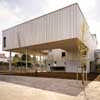
photo : Gilbert Fastenaekens
Charleroi Photography Museum Extension images / information from l’Escaut Architecture
Location: Mont-sur-Marchienne, Belgium, western Europe
Architecture in Belgium
Architectural Tours – city walks
Website: www.museephoto.be
Belgium Court of Justice, Hasselt
Hergé museum, Louvain-la-Neuve
Comments / photos for the Charleroi Museum of Photography building page welcome

